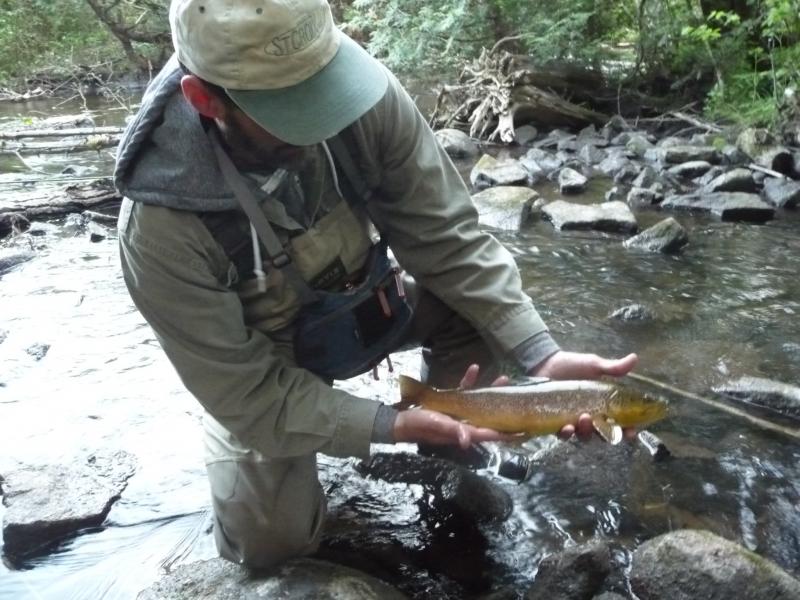
Canada at the Great International Fisheries Exhibition (1883)
Canada at the Great International Fisheries Exhibition (1883)
Publications such as this helped distribute the proceedings of the exhibition and both the ideological and technological aspects of fish culture to a broad audience.
1883 International Fisheries Exhibition (London, England)
 This work is licensed under a Creative Commons Public Domain Mark 1.0 License.
This work is licensed under a Creative Commons Public Domain Mark 1.0 License.
London, England’s Great International Fisheries Exhibition in 1883 was the largest fisheries conference of its time and helped establish fish culture as a global fisheries management tool. Governments from across the globe sent agents to display elaborate exhibits about their nation’s aquatic natural history and to network with other fisheries experts. Exhibits on the artificial breeding and rearing of fish, such as the one created by Canada’s Samuel Wilmot, were the highlight of the event.
The knowledge and networks established at the exhibition acted as a catalyst for the acclimatization of trout throughout the world. The science and technology of aquaculture aided trout in becoming a remarkably mobile species in the late nineteenth and early twentieth centuries. Three species of trout in particular, brown, brook, and rainbow, have expanded far beyond their native ranges and now occupy nearly every corner of the planet.
The scientific practice of artificially breeding fish began in mid-eighteenth-century France and quickly spread throughout the world. While governments were interested in fish breeding for its food-bearing potential, anglers and sportsmen also helped facilitate the spread of fish culture. Popular sporting publications such as Britain’s The Field and the United States’s Spirit of the Times provided a platform for the dissemination of both the technical and ideological foundations of artificial fish breeding to sportsmen and sporting organizations throughout the world.
Rainbow trout, the most dispersed of the three cosmopolitan fish, had a native range restricted to the west coast of North America and a few other places in the northern Pacific Rim. Brook trout were originally limited to the North American Great Lakes Basin, and brown trout were indigenous to western Europe and the British Isles. The three trout species share similar environmental regulators. This facilitated their introduction into each other’s native range and just about any body of water that could support them. Indeed, many waters throughout the world now hold all three varieties of trout.

Non-native brown trout caught with a fly rod on a small stream in Southwestern Ontario, Canada.
Non-native brown trout caught with a fly rod on a small stream in Southwestern Ontario, Canada.
All rights reserved © 2012 William Knight
The copyright holder reserves, or holds for their own use, all the rights provided by copyright law, such as distribution, performance, and creation of derivative works.
New Zealand and Australia, which did not originally have any trout species but did have the necessary environmental conditions, had brown, brook, and rainbow trout acclimatized into their waters around the turn of the twentieth century. The global introduction of trout was made possible by the invention of a relatively simple technology allowing the long-distance transportation of fertilized fish eggs. Wood boxes, insulated with moss and cooled by large blocks of ice, permitted eggs to be shipped across the world, even across tropical climates, without harm.

The global (re)distribution of trout
The global (re)distribution of trout
2013 Michael Del Vecchio
This map was created using QGIS, an open-access mapping software. This map is based of a series of maps by H. R. MacCrimmon originally published in the Journal of the Fisheries Research Board of Canada.
Map sources:
MacCrimmon, H.R., and T.L. Marshall. “World Distribution of Brown Trout, Salvelinus fontinalis.” Journal of the Fisheries Research Board Canada 25, no. 12 (1968): 2527–48.
MacCrimmon, H. R., and J. S. Campbell. “World Distribution of Brook Trout, Salvelinus fontinalis.” Journal of the Fisheries Research Board Canada 26, no. 7 (1969): 1699–725.
MacCrimmon, H. R., T. L. Marshall, B. L. Gots. “World Distribution of Brown Trout, Salvelinus fontinalis: Further Observations.” Journal of the Fisheries Research Board Canada 27, no. 4 (1970): 811–18.
 This work is licensed under a Creative Commons Attribution-NonCommercial-ShareAlike 3.0 Unported License.
This work is licensed under a Creative Commons Attribution-NonCommercial-ShareAlike 3.0 Unported License.
The science, technology, and ideology of artificial fish breeding left a lasting impression on aquatic communities the world over. Trout is but one example. Understanding the international history of trout demonstrates the ways in which scientific development, technological innovation, cultural initiatives, and living organisms combined to construct the current global environment.
How to cite
Del Vecchio, Michael. “Cosmopolitan Trout: The 1883 Fisheries Exhibition and the Global Expansion of Fish Culture.” Environment & Society Portal, Arcadia (2013), no. 21. Rachel Carson Center for Environment and Society. https://doi.org/10.5282/rcc/5653.
ISSN 2199-3408
Environment & Society Portal, Arcadia
 This work is licensed under a Creative Commons Attribution-NonCommercial-ShareAlike 3.0 Unported License.
This work is licensed under a Creative Commons Attribution-NonCommercial-ShareAlike 3.0 Unported License.
2013 Michael Del Vecchio
This refers only to the text and does not include any image rights.
Please click on the images to view their individual rights status.
- Halverson, Anders. An Entirely Synthetic Fish: How Rainbow Trout Beguiled American and Overran the World. New Haven: Yale University Press, 2010.
- Kinsey, Darin. “Seeding the Water as the Earth: The Epicenter and Peripheries of a Western Aquacultural Revolution.” Environmental History 11 (2007): 527–66.
- Knight, William. “Samuel Wilmot, Fish Culture, and Recreational Fisheries in Late 19th Century Ontario.” Scientia Canadensis 30 (2007): 75–90.
- Owen, James. Trout. London: Reaktion Books, 2012.
- Reiger, John F. American Sportsmen and the Origins of Conservation. Oklahoma: University of Oklahoma Press, 1975.
- Szylvian, Kristin M. “Transforming Lake Michigan into the ‘World’s Greatest Fishing Hole’: The Environmental Politics of Michigan’s Great Lakes Sport Fishing, 1965–1985.” Environmental History 9, no. 1 (2004): 102–27.
- Taylor, Joseph. Making Salmon: An Environmental History of the Northwest Fisheries Crisis. Seattle: University of Washington Press, 1999.








